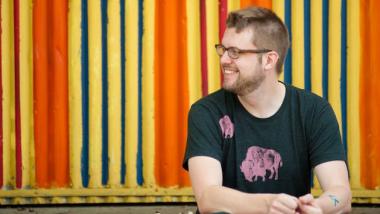
Robert Honstein is part of the composers’ collective Sleeping Giant, which seems to function as a way for like-minded colleagues to market themselves under a catchy name. Sleeping Giant’s members, who besides Honstein include Timo Andres, Christopher Cerrone, Jacob Cooper, Ted Hearne, and Andrew Norman, undertake both collaborative and individual projects. (Even when they work collaboratively, as on Eighth Blackbird’s 2016 Hand Eye, their contributions are individual.)
Honstein has the spotlight to himself on An Economy of Means (New Focus), and though he has written plentifully for ensembles, the works here are for soloists — the percussionist Doug Perkins and the pianist Karl Larson, both exceptional interpreters who specialize in new music.
That the music is for solo instruments explains the album’s title; as Andres, Honstein’s Sleeping Giant colleague, writes in a philosophical liner note, “a major topic of An Economy of Means is the inherent drama of a lone performer tackling a large-scale work.”
 We’re used to hearing pianists do that, in reams of 19th-century scores, right up through contemporary works. We’re even, in the age of Evelyn Glennie, used to solo percussion works. But this album’s title work is a true oddity — a six-movement suite for which Perkins has only a vibraphone (and, Andres tells us, “a large battery of mallets and strategically-placed props), rather than the stage full of noisemakers that percussionists typically have on hand.
We’re used to hearing pianists do that, in reams of 19th-century scores, right up through contemporary works. We’re even, in the age of Evelyn Glennie, used to solo percussion works. But this album’s title work is a true oddity — a six-movement suite for which Perkins has only a vibraphone (and, Andres tells us, “a large battery of mallets and strategically-placed props), rather than the stage full of noisemakers that percussionists typically have on hand.
That said, an agile player with two hands full of mallets can get plenty of music from a vibraphone, and if Honstein’s “means” here are economical, his score is an opulent exploration of the instrument’s techniques and expressive range. And that is doubly so when the vibraphone is “prepared,” like a Cagean prepared piano. Nothing in the notes tell us exactly what “prepared” means, for a vibraphone, but you can deduce the setup from the sound of certain movements — for example, “Cross Fit,” in which the vibraphone keys produce an attenuated, percussive sound, much like that of a piano prepared by placing pieces of wood or metal in the strings.
The opening movement, “Filigree,” uses the vibraphone’s upper range, and at first evokes the timbres and chance qualities of wind chimes, presented in a speedily swirling figure, sometimes with a graceful if constricted melody floating over it. The effect is hypnotic, but just as you settle into it, Honstein changes the structure, punctuating what at first was a perpetual motion piece with brief stopping points that let the vibraphone timbre ring out — as if you’re watching a film running at high speed, punctuated by still frames.
Honstein is clearly drawn to sharp contrasts. He follows the brisk, flighty “Filigree” with “Chorale,” a meditative movement, built around a sequence of mid-range, vibrating tones, with other tones fading in as a kind of glacial counterpoint. “Fast Notes, Long Tones” is largely as advertised, though title hardly does justice to the movement’s intricacies. It begins, for example, with a rhythmic pattern, hand-slapped on a part of the instrument that produces no tones, and a steady, watch-like ticking, while a brisk figure is played so quietly that it sounds almost as if it’s in another room.
The ticking, it becomes clear later in the work, is actually the sound of the mallets hitting the keys, although at this point, the impact is louder than the note; later, when the figure returns at a higher volume, the link between the tones and the tapping is clearer. The piece unfolds organically: the pianissimo figure grows louder and more involved, the hand-slapping percussion ceases, and a second layer built of ringing, sustained tones takes over the foreground.
In “Cross Fit,” an angular, almost cartoonishly humorous movement, Honstein moves deeper into the intersection between purely percussive sounds (which vibraphonists are not often called upon to produce) and long-lined melodic figures (which is their more familiar milieu). Here, the percussive timbres are hard and solid, sometimes like a hammer on wood, sometimes like a guitar pick gliding across muted zither strings, and sometimes like the metallic tones of a gamelan orchestra. The one thing the instrument does not sound like is a vibraphone.
More traditional timbres, or something closer to them, return in “Broken Chords,” a dreamy, rich-textured minimalist essay on repeated tones and intervals, and a return of the chime sound — but lower in the vibraphone’s range — heard earlier in “Filigree.” The slow-moving finale, “Bowed Lines,” takes another left turn, with Perkins trading in his mallets for stringed instrument bows, to produce sustained tones with rich overtones, which melt together into an appealing chordal haze.
The piano work, Grand Tour, is a travelogue of sorts, in the tradition of Liszt’s Années de Pèlerinage. Though some of Honstein’s titles are vague (“Cruise Ship” and “Lagoon,” for example), others locate the tour somewhere in Italy (“Palazzo” and “Passeggiata” — the latter a reference to the traditional Italian evening stroll), with only “Strada Nuova” referring to a specific place, a scenic boulevard in Venice.
Not that it matters, greatly. It’s not as though Honstein draws on folk themes or Italian dance rhythms, as Mendelssohn did with the Saltarello at the end of his “Italian” Symphony. In a way, Honstein is really touring the keyboard, much as An Economy of Means toured the vibraphone, but this time without any physical and timbral alterations.
The set is framed by a pair of nearly (but not entirely) identical movements, both called “Per,” in which a single line of four-note motivic cells gradually makes its way up the keyboard, and then down, with the sustain pedal building a hazy, atmospheric backdrop around them. “Per” seems deliberately bland: the motivic blocks are played in a steady, four-square rhythm, with no changes of dynamics or coloration. But then, there are long stretches of Bach that, on the page (that is, without the expressive elements that interpreters bring to them), seem to behave similarly; think of the Prelude of the first unaccompanied cello suite. Here, that straightforwardness has a distinct function, first as a stage-setter, then as a return to the journey’s starting point — another move taken from Bach’s playbook, this time the Goldberg Variations.
In between, Honstein is unconstrained in matters of style, and the eras particular styles represent. “Strada Nuova” begins with the drive and harmonic character of a Romantic etude, but Honstein hijacks its Chopinesque spirit and melds it with a post-minimalist approach to repetition (rhythmically, if not harmonically). The minimalist-Romantic blend returns later in the set, in “Lagoon,” where rippling figures give way to themes rooted in repetition, and even, very briefly, a chord progression that is pure Philip Glass, offered more as a tip of the hat than an outright lift. As the work evolves (at 8:57, it is the longest movement in the set), Minimalism, Romanticism and even a bit of impressionism jostle for the spotlight.
Whatever palazzo inspired the movement of that name seems to have captured Honstein’s visual and historical imagination: the movement is clean, bright and sharply articulated, with Baroque decorative flourishes that evoke formality and grandeur. “Cruise Ship” and “Passeggiata” seem visually-inspired as well. In the first, a placid, slow opening section giving way to a long section of pure Romantic display, with crashing chords, octave doublings and anxiety-laden harmonies. And that section, in turn, gives way to a quiet, melancholy, virtually eventless coda.
Given the movement’s title, it’s hard not to hear the piece in cinematic terms, as a cruise that began in calm waters but ran into a storm so violent as to sweep everyone off, leaving a ghost ship in its wake. The far more restrained “Passeggiata” evokes this sort of imagery as well. In this case, Honstein’s music blends prairie-era Copland and harmonizations borrowed from Renaissance vocal music, with occasional bursts of unprepared dissonance disrupting the flow, suggesting a portrait of an American strolling through an Italian village, struck, perhaps, by the coexistence of antiquity and modernity.
That could be overreaching, of course, but it has been a long time since classical instrumental music sounded so unabashedly narrative. Honstein gets away with it because he has so much going on, in so many competing styles, often an undercurrent of dry humor — and because interpreters as eloquent as Larsen and Perkins are able to balance those elements perfectly.
Rob Schwimmer’s new disc, Heart of Hearing (Sunken Heights Music) is as stylistically freewheeling as Honstein’s album, but with a different collection of styles in play. In concert, I’ve heard Schwimmer mainly as a composer and performer on the theremin and other electronic instruments, usually with new- music groups and orchestras. But there is a lot more to his border-free musical world. He is also a magnificent jazz pianist, with a fleet, subtle touch, and has worked with pop musicians of all stripes, from the Everly Brothers, Simon and Garfunkel, and Willie Nelson to Bela Fleck and Vernon Reid. He is also, with Mark Stewart, the guitarist in the Bang on a Can All Stars, half of Polygraph Lounge, a musical comedy group that works in the tradition of Spike Jones and P.D.Q. Bach.
Heart of Hearing touches on several of those involvements, and it’s tempting to see it as a manifesto of sorts — a proclamation that all styles are fair game if you can play them convincingly and if you have the technique and imagination to move between them without ever sounding out of your element.
 Schwimmer composed most of the music here, and when he tackles music by other composers — a fascinating selection, ranging from Chopin to Nikolai Obukhov to Bernard Herrmann, Kurt Weill, Paul Simon, and Adam Guettel — he reconfigures them in his own image, as quirky virtuoso pieces with surprising twists. His Obsession No. 1: cChHoOpPiInN, for instance, takes the closing Presto of Chopin’s Sonata No. 2, and subjects it to a retooling in which Chopin’s right- and left-hand lines are staggered so that the movement’s unison octaves are displaced. Some internal rhythms are tweaked, as well, an almost microscopic move that changes the character of the phrasing. It’s obviously not how you want to hear the movement all the time, but it has a fascinating fun-house mirror effect, as well as an extra measure of virtuosity, given a pianist’s natural tendency to move the right- and left-hand music back into synch.
Schwimmer composed most of the music here, and when he tackles music by other composers — a fascinating selection, ranging from Chopin to Nikolai Obukhov to Bernard Herrmann, Kurt Weill, Paul Simon, and Adam Guettel — he reconfigures them in his own image, as quirky virtuoso pieces with surprising twists. His Obsession No. 1: cChHoOpPiInN, for instance, takes the closing Presto of Chopin’s Sonata No. 2, and subjects it to a retooling in which Chopin’s right- and left-hand lines are staggered so that the movement’s unison octaves are displaced. Some internal rhythms are tweaked, as well, an almost microscopic move that changes the character of the phrasing. It’s obviously not how you want to hear the movement all the time, but it has a fascinating fun-house mirror effect, as well as an extra measure of virtuosity, given a pianist’s natural tendency to move the right- and left-hand music back into synch.
For The Russian Mystic: Obukhov’s Prelude No. 1, Schwimmer turns an attractive, if obscure piano piece, composed around 1915, into a duet for piano and Haken Continuum, a flexible, polyphonic synthesizer with a smooth fingerboard on which the traditional keyboard layout is printed, giving a player ample articulation options. Schwimmer gives Obukhov’s graceful melody a timbre that combines the characteristics of a clarinet and a flute and plays it with a sensitive vibrato that lets it sing, while playing the accompaniment more straightforwardly on the piano.
The other Obsession arrangements, scattered through the album, are a compelling take on Herrmann’s Prelude and Scene d'Amour from his score for Alfred Hitchcock’s Vertigo, and the Octet from Guettel’s Light in the Piazza. They are virtuoso showpieces; indeed, Schwimmer calls his take on Guettel’s musical a “concert paraphrase,” an appellation that evokes Lizst and Gottschalk, and he plays it in a style those towers of Romantic pianism would recognize.
The Guettel benefits from an extraordinary level of detail, including hints of the original’s orchestration in brusquely attacked, fortissimo chords, from which graceful melodies flow. Mostly, though, Schwimmer examines Guettel’s score through a larger-than-life Romantic prism. The Herrmann offers a different bag of tricks: Schwimmer’s version begins with the piano in the distance, heard through a scrim of vinyl scratchiness, a pair of effects that fall away quickly as Schwimmer channels the technical grandeur of late Romanticism, an approach entirely suited to the anxiety that drives Herrmann’s score (not to mention the film he composed it for).
Another set of arrangements, Halluciations on Popular Songs, offers a suitably jazzy rendering of “In the Wee Small Hours of the Morning,” and a version of “Lost in the Stars,” in which Schwimmer plays the melody on the theremin, summoning an eerily vocal timbre that, when played in a lower range (as it is, at first) is not far from that of Lotte Lenya’s 1944 recording (with Weill at the piano). The arrangement, though, is also a tribute to Mary Cleere Haran, a singer with whom Schwimmer worked, and who was killed in a bicycle accident in 2011. Toward the end, the melody, now played in a higher register, is interrupted by a violent crash, followed by a long, descending keyboard spill. When the theremin melody returns, it is distant and bathed in reverb.
Still, the most striking of the three is a piano setting of “Sounds of Silence,” recast with flatted intervals that make this version sound even darker and more haunting than the original, and with some structural tweaks that move the signature guitar introduction from the Simon and Garfunkel original to the end of each verse.
Schwimmer’s own works are as varied as his arrangements. The two movements of Terra Firma — “Here We Are” and “The Question” — are steeped in the harmonic ambiguities of Impressionism, but also embrace the melodic turns of jazz. A different side of Impressionism — its painterly aspect — drives the three distinctly pictorial selections from Sonic Ginger: “Sparks” is etched in short bursts of rapid notes; “A Feather Blown By the Wind” uses brisk, light passage work to create the image suggested by the title, and the rolled figures in the minute-long “In a Japanese Garden” evoke a blend of antiquity, stateliness and mystery.
Schwimmer’s Two Short Scenes are similarly descriptive, presented with impressive concision. Harmonic haziness gives way to frenetic, angular, exploratory bursts in “Waking Up in a Strange Place,” and “Mist/The Seduction” draws again on the Impressionists, this time on the style’s distinctive approach to water imagery, which morphs into a sultry meditation in its final bars.
Americana sees him testing other accents. The chorale-like “Hard Times” tempers Ivesian dissonance with jazz inflections. And “Introduction and Home Away From Home” channels the late 19th-century salon style — as well as cowboy-movie saloon music — with an opulently harmonized and elaborately decorated version of “Home on the Range” cropping up every now and again.
Schwimmer’s finale, In the Company of Friends: Accepting It, is a short, eventful jazz workout, recorded in 1989 with bassist Jay Anderson and drummer Jeff Hirschfeld. Where Schwimmer’s other jazz-tinged pieces here are hybrids with classical style, this closing piece focuses on his jazz moves, which have an assured sparkle. Of course, if you’re looking for hybrids, you can find them: the piece’s refrain, a simple turn-around, with three descending and two ascending notes, bears an uncanny resemblance to the Beatles’ “If I Fell.”
The pianist Simone Dinnerstein and A Far Cry, a superbly polished, Boston-based chamber orchestra, gave the premiere of Philip Glass’s Piano Concerto No. 3 in September 2017, and quickly took the work. along with Bach’s Keyboard Concerto No. 7 in G minor (BWV 1058), into the recording studio. Both are included on Circles (Orange Mountain Music), a disc named, at least in part, because of the circular setup the musicians adopted during the sessions, with the piano at the center (rather than out front) and the orchestra’s strings surrounding it.
Pairing Bach and Glass makes sense, here. Dinnerstein began her career with a thoughtful recording of Bach’s Goldberg Variations and, in his brief liner note, Glass says that it was as a Bach interpreter that he first heard her. (He then adds that he did not have Bach in mind when he composed the new concerto, but then doubles back to suggest that, having studied Bach intensively as a student of Nadia Boulanger, the Baroque master’s music is part of his musical DNA.)
Dinnerstein, in her own note, argues for the Glass-Bach connection, on the grounds that both composers use repetition. That’s true in a literal sense, although the difference in the way they use it is so vast that it’s hard not to see Dinnerstein’s assertion as a provocation, meant to kindle debate about the value of repetition in music and what it’s limits are. Of course, if Dinnerstein wanted to argue the point, she need only point to the repeated arpeggios at the start of the second movement of her Glass concerto, and to the similarly arpeggiated Bach cello prelude to which I likened Honstein’s “Per.”
 But for all that, the repetition discussion is a red herring. Glass still uses it, plentifully — but not in the way he used to, when he was first tagged as a composer who repeats simple ideas over, and over, and over, and over, and…well, you know. In his early days, repetition was the fuel that drove the music, but the real engine was what he called additive process — the gradual addition of new notes to a repeating figure, which changed the figure itself and moved the work forward. That movement would be slow, by definition; the pieces could unfold over several hours.
But for all that, the repetition discussion is a red herring. Glass still uses it, plentifully — but not in the way he used to, when he was first tagged as a composer who repeats simple ideas over, and over, and over, and over, and…well, you know. In his early days, repetition was the fuel that drove the music, but the real engine was what he called additive process — the gradual addition of new notes to a repeating figure, which changed the figure itself and moved the work forward. That movement would be slow, by definition; the pieces could unfold over several hours.
This concerto runs just over 33 minutes, and is set in three movements, the last of which is dedicated to Arvo Pärt, and alludes to that composer’s own brand of patient thematic evolution. Elsewhere, Glass taps into a neo-Romantic current that he has explored, on and off, since Koyaanisqatsi, in 1982. The work’s solo piano opening, for example, is a fairly typical Glassian chord progression, but it is kitted out with a chromatic left-hand part that makes it sound more like Chopin than Glass. Chopinesque turns are heard elsewhere too, and the work, while essentially introspective (all three movements are fairly slow) has the kind of dynamic fluidity — grand climaxes, even — that you would not have heard in early or even much middle period Glass.

It would be too much to say that this is a groundbreaking work within the Glass canon. But it is an attractive, slightly melancholy score that I like more with every hearing. Glass has written to Dinnerstein’s strengths (sharply articulated, poetic phrasing, for example), and both she and Far Cry play it with greater passion and suppleness than you often hear in recordings of Glass’s music.
As for the Bach, my own preference is for the transparent textures and lithe phrasing that are more typically the province of period instrument performances, though there are performances on modern instruments I admire. This one has considerable drive and energy in its favor, but it strikes me as heavy and opaque. You can think of it as retro, perhaps, and there are listeners who prefer that. But then, it’s hard to imagine that many people will consider buying this disc on the basis of the Bach alone.

